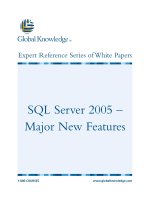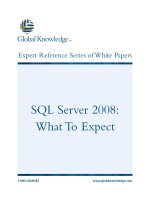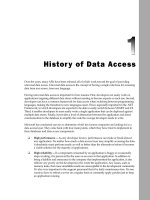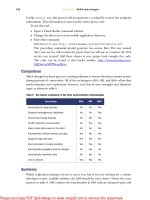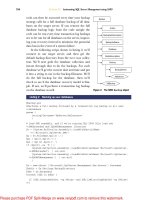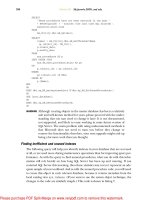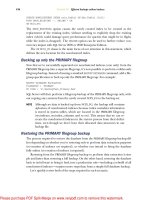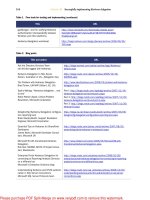Tài liệu SQL Server 2005 Reporting Services in Action ppt
Bạn đang xem bản rút gọn của tài liệu. Xem và tải ngay bản đầy đủ của tài liệu tại đây (23.19 MB, 601 trang )
SQL Server 2005
Reporting Services in Action
SQL Server 2005
Reporting Services
in Action
Revised Edition of
Microsoft Reporting Services in Action
BRET UPDEGRAFF
MANNING
Greenwich
(74° w. long.)
For online information and ordering of this and other Manning books, please go to
www.manning.com. The publisher offers discounts on this book when ordered in
quantity. For more information, please contact:
Specail Sales Department
Manning Publications Co.
Cherokee Station
PO Box 20386 Fax: (609) 877-8256
New York, NY 10021 email:
©2007 by Manning Publications Co. All rights reserved.
No part of this publication may be reproduced, stored in a retrieval system, or transmitted,
in any form or by means electronic, mechanical, photocopying, or otherwise, without prior
written permission of the publisher.
Many of the designations used by manufacturers and sellers to distinguish their products are
claimed as trademarks. Where those designations appear in the book, and Manning
Publications was aware of a trademark claim, the designations have been printed in initial
caps or all caps.
Recognizing the importance of preserving what has been written, it is Manning’s policy to have
the books we publish printed on acid-free paper, and we exert our best efforts to that end.
Manning Publications Co.
Cherokee Station Copyeditor: Liz Welch
PO Box 20386 Typesetter: Denis Dalinnik
New York, NY 10021 Cover designer: Leslie Haimes
ISBN 1-932394-76-1
Printed in the United States of America
1 2 3 4 5 6 7 8 9 10 – VHG – 10 09 08 07 06
To Daniel, for your inspiration
vii
brief contents
1 Introducing SQL Server 2005 Reporting Services 1
2 Report authoring basics 41
3 Working with data 64
4 Designing reports 104
5 Using expressions and functions 150
6 Using custom code 185
7 Ad hoc reporting with the Report Builder application 215
8 Managing the Reporting Services environment 259
9 Securing Reporting Services 311
10 On-demand report delivery 341
11 Mastering the ReportViewer controls 389
12 Subscribed report delivery 420
13 Extending Reporting Services 453
14 Performance and scalability 497
appendix A Installing SQL Server Reporting Services 524
appendix B Understanding .NET code access security 531
ix
contents
foreword xvii
foreword to the first edition xix
preface xxi
preface to the first edition xxii
acknowledgments xxiv
about this book xxvi
about the source code xxix
about the authors xxxiv
about the cover illustration xxxv
1 Introducing SQL Server 2005 Reporting Services 1
1.1 What is Reporting Services? 2
Solving reporting problems with Reporting Services 3
Choosing a Reporting Services edition 4
Reporting Services and the Microsoft SQL Server platform 6
1.2 Reporting Services at a glance 7
Authoring features 8 ✦ Management features 10
Delivery features 11
✦ Extensibility features 11
Scalability features 12
✦ Security features 12
Deployment features 12
1.3 RS architecture 13
The Report Server engine 15 ✦ The Report Server
database 16
✦ The Report Manager 17
1.4 Understanding report processing 19
Execution stage 20 ✦ Rendering stage 20
1.5 Delivering reports 22
On-demand delivery 22 ✦ Subscribed delivery 23
1.6 What is the report lifecycle? 24
x CONTENTS
1.7 RS in action 25
About the Adventure Works Reporter 26
Your first report 26
1.8 Evaluating RS 36
1.9 Summary 37
Part 1 Authoring reports 39
2 Report authoring basics 41
2.1 The report-authoring process: step by step 42
Analysis 43 ✦ Construction 43 ✦ Testing 44
Deployment 44
2.2 Authoring reports in VS .NET 44
Authoring reports with the Report Wizard 45
Authoring reports with the Report Designer 46
Importing reports from Microsoft Access 55
2.3 Creating reports programmatically 57
Generating RDL: The AW Ad Hoc Reporter 59
Implementation details 60
2.4 Summary 62
3 Working with data 64
3.1 Working with data sources 64
Connecting to the database 65 ✦ Choosing an authentication
mechanism 70
✦ Deploying data sources 78
3.2 Working with report datasets 78
Understanding the dataset definition 79 ✦ Creating a report
dataset 80
✦ Using multiple datasets 84
3.3 Authoring dataset queries 85
Using the Graphical Query Designer 85 ✦ Using the Generic
Query Designer 87
3.4 Parameter-driven reports 90
The role of parameters 90 ✦ Building parameter-driven
queries 91
✦ Setting up the report-level parameters 93
3.5 Working with stored procedures 98
Using a stored procedure as a dataset query 98
Defining query-based lookup parameter values 100
Creating cascading parameters 101
✦ Working with
multivalued parameters 102
3.6 Summary 102
CONTENTS xi
4 Designing reports 104
4.1 Anatomy of a report 105
Getting started with a new report 106 ✦ Understanding report
sections 106
✦ Understanding report items 107
Understanding data regions 110
4.2 Designing tabular reports 112
Tabular reports with groups 113 ✦ Parameterized tabular
reports 116
✦ Tabular reports with interactive features 121
Table region limitations 123
4.3 Designing freeform reports 123
Freeform reports with nested regions 123
Grouping freeform data 125
Freeform reports with side-by-side data regions 127
4.4 Designing chart reports 128
The chart data region 129 ✦ Working with charts 129
Nesting chart regions 132
4.5 Designing crosstab (matrix) reports 133
Matrix region advantages 133 ✦ Working with the matrix
region 134
✦ Adjusting the report layout 138
4.6 Using other design features in your reports 140
Setting up multiple columns 140 ✦ Adding interactive
sort 142
✦ Passing multivalued parameters into a stored
procedure 144
✦ Designing subreports 145
4.7 Summary 148
5 Using expressions and functions 150
5.1 Understanding expressions 151
Using the Expression Editor 152 ✦ Expression syntax 153
Determining expression execution order 154
✦ Understanding
expression scope 154
✦ Dealing with expression errors 156
5.2 Exploring the Report Object Model 157
Using the ReportItems collection 159 ✦ Using the Fields
collection 163
✦ Using the Parameters collection 166
Using the Globals collection 166
✦ Using the User
collection 167
5.3 Working with functions 167
Referencing external functions 168 ✦ Using aggregate
functions 168
✦ Using other internal functions 173
5.4 Designing reports with navigational features 175
Reports with hyperlinks 176 ✦ Reports with
document maps 178
xii CONTENTS
5.5 Report rendering considerations 181
Exporting reports to HTML 181 ✦ Exporting reports to
MHTML 182
✦ Exporting reports to other formats 182
5.6 Summary 183
6 Using custom code 185
6.1 Understanding custom code 186
Using embedded code 186 ✦ Using external assemblies 189
6.2 Custom code in action: implementing report forecasting 193
Forecasting with OpenForecast 194 ✦ Implementing report
forecasting features 194
6.3 Using XML-based reports 207
Understanding XML exporting 208 ✦ Exposing the report
content as an RSS feed 209
6.4 Summary 213
7 Ad hoc reporting with the Report Builder application 215
7.1 About the Report Builder application 216
A quick tour of the Report Builder 217 ✦ Setting up
for ad hoc reporting 218
✦ The Developer toolset for
ad hoc reporting 220
7.2 Building the Report Model using BIDS 221
Building a report model project 222 ✦ Setting up
the data source 223
✦ Creating a data source view 227
Building the report model 233
✦ Deploying report
models 241
7.3 Ad hoc reporting in action 242
Launching the Report Builder 242 ✦ Creating the Product
Profit Margin report 244
✦ Getting more with infinite
drill-through reporting 247
✦ Advanced filtering with the
Report Builder 249
7.4 Implementing Report Builder security 252
Securing the Report Builder with roles 252 ✦ Securing report
model items 253
7.5 Summary 255
CONTENTS xiii
Part 2 Managing reports 257
8 Managing the Reporting Services environment 259
8.1 Managing RS with the Report Manager 260
How the Report Manager works 260 ✦ Managing Report Server
settings 263
✦ Managing content 268 ✦ Managing report
execution 275
✦ Managing linked reports 286
8.2 Managing RS with the Web service 288
Using the Web service management API 288 ✦ Tracing calls to
the SOAP API 289
✦ Deploying reports
programmatically 292
✦ Batching methods together 295
8.3 Managing RS with the WMI provider 296
Understanding the WMI provider 296 ✦ Implementing an RS
management console 297
8.4 Other ways to manage Reporting Services 299
Managing RS with SQL Management Studio 299 ✦ Managing
RS with the script host 300
✦ Using the Reporting Services
configuration tool 302
8.5 Analyzing report execution 305
Analyzing the Report Server execution log 305 ✦ Analyzing
trace log files 307
8.6 Summary 309
9 Securing Reporting Services 311
9.1 Role-based security basics 312
The purpose of role-based security 312 ✦ Authentication
models: using Windows or creating your own 312
9.2 Windows authentication: a closer look 313
Exploring the Client-to-Report Server model 314 ✦ Exploring
the Client-to-Façade-to-Report Server model 316
9.3 Using role-based authorization 318
Understanding tasks 319 ✦ Defining roles 320
Understanding securable items 321
✦ Defining policies 322
9.4 Managing role-based security with the Report Manager 324
Creating Windows user accounts and groups 325 ✦ Creating
custom roles 326
✦ Defining security policies 327
9.5 Managing role-based security with the Web service 329
Determining role-based security policies 329 ✦ Calling security-
related Web service methods 330
✦ Implementing “pseudo”
report events 332
xiv CONTENTS
9.6 Techniques for advanced security issues 333
Filtering data 334 ✦ Using dynamic dataset queries 335
Hiding data 337
✦ Implementing custom security
models 337
✦ Enforcing a secured connection to the
Report Server 337
9.7 Summary 338
Part 3 Delivering reports 339
10 On-demand report delivery 341
10.1 How RS provides on-demand report delivery 342
10.2 URL-based report access 343
Understanding URL syntax 344 ✦ Requesting resources
by URL 345
✦ Requesting reports by URL 347
Working with report commands 348
✦ Working with the
HTML Viewer 351
10.3 URL access in action 354
URL Access with WinForms: AccessOptions 355 ✦ URL Access
with WebForms: AWReporterWeb 358
10.4 Web service-based report access 366
Requesting reports with SOAP 368 ✦ Rendering images 370
Handling report sessions 373
10.5 Web service access (SOAP) in action 376
Generating report requests with SOAP on the client side 376
An automation solution: AW Campaigner 379
10.6 Evaluating URL and Web service access options 383
Evaluating URL access 384 ✦ Evaluating Web service
access 385
✦ Choosing an integration approach 386
10.7 Summary 387
11 Mastering the ReportViewer controls 389
11.1 How the .NET ReportViewer controls work 390
Controls for web and Windows applications 390 ✦ Choosing
remote or local mode 391
✦ Managing properties of the
ReportViewer controls 392
11.2 Using ReportViewer in remote mode 394
Creating, configuring, and running the control 394
Additional customizations for the ReportViewer control 397
CONTENTS xv
11.3 Using ReportViewer in local mode 397
Creating a local report with a database as the data source 398
Creating a local report with an object as the data source 401
11.4 Custom validation with the ReportViewer control 406
Creating a parameters section 407 ✦ Creating event
methods 407
✦ Write validation code 410
11.5 Converting report files 411
Converting RDL files into RDLC files 412
Converting RDLC files into RDL files 415
11.6 Deploying applications that use ReportViewer controls 416
Redistributing the ReportViewer controls 416 ✦ ReportViewer
deployment for Windows applications 417
✦ ReportViewer
deployment for web applications 418
✦ Using the
ReportViewer web server control in a web farm 418
11.7 Summary 418
12 Subscribed report delivery 420
12.1 Understanding subscribed report delivery 421
Subscription-based reporting scenarios 421 ✦ The subscriber-
publisher design pattern 422
✦ How the RS subscription-based
model works 422
12.2 Configuring subscribed report delivery 425
Creating a new subscription 426 ✦ Choosing the
subscription type 427
✦ Configuring delivery extensions 430
Managing subscriptions 432
12.3 Subscribed report delivery in action 434
“Pushing” reports via standard e-mail subscriptions 434
Archiving reports to a file share 437
✦ Sending reports to a data-
driven list of recipients 440
✦ Triggering subscriptions
programmatically 446
12.4 Summary 450
Part 4 Advanced reporting 451
13 Extending Reporting Services 453
13.1 Understanding Reporting Services extensibility 454
Interface-based programming 454 ✦ Working with interface
inheritance 456
✦ Extending RS with interface
inheritance 459
xvi CONTENTS
13.2 Reporting with a custom dataset data extension 460
Identifying design goals and trade-offs 461 ✦ Authoring dataset-
bound reports 462
✦ Implementing the custom dataset
extension 469
✦ Debugging dataset extensions 473
13.3 Distributing reports to Web services using custom delivery extensions 473
Design goals and trade-offs 474 ✦ Using the custom delivery
extension 475
✦ Implementing the custom delivery
extension 476
✦ Debugging custom delivery extensions 480
13.4 Implementing custom security 482
Design goals and trade-offs 485 ✦ Intranet reporting
with custom security 486
✦ Implementing the custom
security extension 488
✦ Debugging the custom security
extension 495
13.5 Summary 496
14 Performance and scalability 497
14.1 Understanding capacity planning 498
Capacity-planning fundamentals 498 ✦ The capacity-planning
process 503
14.2 Capacity planning for Reporting Services in action 508
Determining requirements 508 ✦ Setting up the testing
environment 511
✦ Performance testing 515 ✦ Analyzing
performance results 516
✦ Identifying resource
constraints 519
✦ Eliminating resource constraints 520
14.3 Summary 523
appendix A Installing SQL Server Reporting Services 524
A.1 Software requirements 524
A.2 Installing SQL Server Reporting Services 525
appendix B Understanding .NET code access security 531
B.1 Code access security basics 532
B.2 Understanding code access terminology 532
B.3 Exploring the RS default security policy 536
B.4 Managing RS code access security 538
resources 542
index 549
xvii
foreword
In my foreword to the first edition, I wrote about the process of creating software at
Microsoft, specifically the first version of
SQL Server Reporting Services. Although
the organic style of software development we used for the initial release of the prod-
uct had proven to be a success, creating the follow-on version would have its own set
of challenges.
After launching the product in early 2004, we turned to planning for the new
release, which was synchronized with the rest of
SQL Server. The release was on track
for a delivery in 2005, which meant we had comparatively little time for development
of new features. In addition, joining the
SQL Server mainline product required the
team to adopt new versions of Visual Studio and the
.NET Framework, and we had
to merge our setup with a new, integrated setup engine. To accommodate this accel-
erated schedule, our original plan was to provide a small set of incremental improve-
ments over the original version. The broad adoption of the product had already given
us a good amount of feedback about what customers felt was missing from the initial
release. From an architectural standpoint, we wouldn’t change the core of Reporting
Services, allowing us to safely add selected features.
At the same time, we also realized that something major was missing from the first
version of the product. While developers and
IT professionals liked the fact that
Report Designer integrated fully into Visual Studio, the most frequent question we
received was, “How can nondevelopers build their own reports?” We knew we had to
address this need with a tool that was easy to use and that didn’t require users to under-
stand a database query language. Fortunately, we didn’t have to start from scratch and
were able to acquire a small company called ActiveViews to provide the core technol-
ogy. The result of this acquisition was Report Builder (discussed in chapter 7). As we
had in our adoption of the
.NET Framework in the first release, we took a gamble
again in adoption of the new ClickOnce technology for Report Builder.
The last piece of the puzzle was to continue our investment in a rich platform for
reporting. Many customers told us that they wanted to easily embed reporting func-
tionality into their applications. So we separated the report viewing components from
the Report Server and provided a rich set of report controls in the release of Visual Stu-
dio 2005. These are covered in depth in chapter 11. We actually rebuilt both the
xviii FOREWORD
Report Manager web application and the Report Designer to leverage the new con-
trols. The end user of these tools will see little difference in the new release, but build-
ing them with the new controls helped us validate their functionality and usability.
Even more than with the first release, books such as Bret Updegraff’s
SQL Server
2005 Reporting Services in Action are critical for helping you get the most out of
Reporting Services. As the capabilities of the product have increased, the information
and guidance that this book provides will help you leverage the Reporting Services
platform to the fullest in your own environment. There are many parts of the product
that we weren’t fully able to expose or document, and this book will help you unlock
some of these hidden gems.
B
RIAN WELCKER
Group Program Manager
Microsoft
SQL Server Reporting Services
xix
foreword to the first edition
May I let you in on a little secret: creating software at Microsoft is pretty similar to
creating software at any other company. I think many people’s perception is that
Microsoft designs products by having an army of market researchers carefully exam-
ine competitive products and survey consumers to determine exactly what features to
include in the next release.
The reality is that most of the ideas that go into Microsoft products are the result
of small teams of people brainstorming in front of whiteboards or chatting in hall-
ways. I’m not saying we don’t know what competitors are doing or what customers
are asking for, but the process of translating real-world scenarios to requirements and
designs is much more organic than you might think. This flexible approach allows
teams to take a fresh look at existing problems, as well as adapt to industry trends
and customer demands.
Case in point: when we started building Reporting Services, we didn’t set out to
copy what other companies had already done. Instead, we asked questions like “What
does it mean to build an enterprise reporting product?” “How do we enable people to
create powerful data visualizations without writing code?” and, most important of all,
“How can we build a platform that people can leverage in their own applications?” The
answer to this final question ended up driving a major portion of the product’s design.
Building a platform is not something to be taken lightly. It requires that you spend
extra time factoring and documenting the interfaces between software components. It
means that your components should not use any “back doors” that are not available
to other developers using the platform. It also can change the order in which you build
the product—you have to focus on the nonvisual parts of the product before you work
on the user-facing ones. For example, the Reporting Services report processing engine
was up and running about a year before the graphical report design tool was ready.
During this time, report definition files had to be hand-coded in order to test any new
report processing features.
The decision to build a platform also means that you will have to spend time on
infrastructure and interfaces at the expense of end-user features. We knew that this
trade-off would mean the first version of Reporting Services might look less feature-rich
than other more “mature” reporting products. We believed this was the right long-term
xx FOREWORD TO THE FIRST EDITION
strategy, as a strong platform would enable others to fill the gaps instead of having to
wait for us to add every feature. When asked about this approach, I sometimes pose
the question, “Is it better to build a car with a powerful engine and fewer lights on the
dashboard, or one with lots of lights that can’t go anywhere?”
One decision we made for our new platform was to bet on another new platform:
.NET. As we had no legacy code to support, we decided early on to make Reporting
Services a 100 percent
.NET application. While this may seem like a no-brainer today,
when we started building Reporting Services the
CLR and the .NET Framework had
not yet been released. Although building an enterprise-quality server product on such
a new technology stack was a little risky at the time, the decision has paid major div-
idends in developer productivity and product quality.
Ultimately, the barometer of whether we have succeeded is what our customers and
partners are able to build on the platform. Since we released the first version of the
product earlier this year, I have seen applications built by customers leveraging the
Reporting Services platform in ways I never imagined. But a platform isn’t useful if
all developers don’t have the know-how to take advantage of it. Because the product
is so new, detailed information and good examples have been sparse and hard to find.
That’s where resources like Teo’s excellent book come in. This book starts by pro-
viding a solid foundation for using the built-in tools included with Reporting Services,
but quickly takes you to the next level by focusing on the programmability and exten-
sibility aspects of the product. The focus on these parts of Reporting Services will help
you leverage and extend the product feature set in your own applications. Teo’s
approach is to provide real-world examples and useful scenarios that walk you through
the details and give you new ideas to explore. Teo has the ability to take complex topics
and break them into smaller sections that can be easily understood. I enjoyed being
one of the book’s technical reviewers as I was able to see how various parts of the prod-
uct came to life on the page. I encourage you to use the ideas in this book and take
Reporting Services to the next level.
B
RIAN WELCKER
Group Program Manager
Microsoft
SQL Server Reporting Services
xxi
preface
Never say never!
About five years ago, I had the unfortunate task of modifying existing reports for
an e-commerce application. I use the word unfortunate because I did not enjoy the
work. My employer at the time was using a reporting application that required writing
Visual Basic 6.0 code to create reports. The idea of programming reports in Visual
Basic was strange to me. I felt I could have simply created web pages to generate the
reports with less effort. After several weeks of working with this application, I vowed
that I would never work with a reporting application again.
For a few years, I managed to successfully avoid any sort of report writing. Then,
about two years ago as I was preparing for one of my exams for my
MSDBA certifica-
tion, an executive at Crowe Chizek, my current employer, came up to me and said
something along the lines of, “Since you are working on your
SQL exam, why don’t
you also spend some time looking into product called Reporting Services?” I admit
that I was hesitant to spend any time with this product. But what I found over time
was not what I expected: I really enjoyed working with Reporting Services—so much,
in fact, that over the next year I made presentations to numerous user groups in three
states touting my newfound knowledge of Reporting Services. This excitement
brought me to TechEd 2005 in Florida, where I met Bill Baker (Microsoft) and his
SQL Server Business Intelligence team. I was motivated by what I learned about SQL
Server 2005 and the Business Intelligence tools, such as Reporting Services, Integra-
tion Services, and Analysis Services.
After returning from TechEd, I helped start a successful
SQL Server user group that
meets monthly in Indianapolis. I spent the last 12 months at Crowe Chizek working
on applications built around Reporting Services. And now, I have coauthored on this
second edition of a book on Reporting Services, a reporting application!
Never say never!
B
RET UPDEGRAFF
xxii
preface to the first edition
In archeology, the Rosetta stone was the key that solved the mysteries of Egyptian
hieroglyphics. I believe that with the release of Microsoft
SQL Server 2000 Reporting
Services, code-named Rosetta, Microsoft gives organizations the key they need to
unlock the secrets of enterprise data and unleash the power hidden within.
Looking retrospectively, Microsoft’s reporting strategy has been confusing, at least
for me. Microsoft Access debuted in the early ’90s with a powerful report designer that
made desktop reporting child’s play.
Enterprise developers, however, have not been that lucky. The lack of comprehen-
sive native reporting capabilities continues even today in the
.NET Framework. True,
some progress has been made with the advent of print-related controls, such as Print-
Document, PrintPreviewControl, and so on, but still, dealing with the
GDI+ (Graphics
Device Interface)
API is usually the last thing a developer wants to tackle when creating
the next line-of-business application. For reasons such as these, report-enabling
Microsoft-centric solutions has been traditionally regarded as a tedious chore.
To address this problem, many of us defected to third-party tools. Others chose to
fill the void with homegrown, customized solutions. While these solutions address
particular needs, they can also be costly, time-consuming, and difficult to implement.
I remember with nostalgia a project that I worked on about five years ago. It called
for developing a reporting solution for a major Fortune 100 company. I implemented
the solution as a server-based framework, following a design pattern similar to the one
discussed in chapter 13. I used Microsoft Access as a reporting tool to generate reports
and save them as snapshot files. Once the report was ready, the Report Server would
e-mail it back to the user or send the user a link to the snapshot file.
Implementing this solution was a lot of fun, but it took a significant development
effort. I wouldn’t have had to go through all this if I had had Reporting Services back
then. Instead of implementing a homegrown solution, I could have used
RS to report-
enable the applications.
For this reason, I was very excited when I heard about Reporting Services in late
2003. Finally, there was an easy way to report-enable different types of applications.
Subsequently, I was involved in a project where I was able to confirm to myself that,
indeed,
RS was the reporting platform I had been dreaming about for years.
PREFACE TO THE FIRST EDITION xxiii
To share my enthusiasm I decided to write a book about Reporting Services. While
I contemplated what the book’s scope would be, it dawned on me that I could bring
the most value by following my heart and approaching Reporting Services from a
developer’s point of view. I put myself in a position that many developers could relate
to. Here I am, a developer, consultant, and architect, who is tasked with adding report-
ing features to a given application. How would I go about this?
To answer this question, my book takes a solution-oriented approach, and more
than half of it is devoted to integrating different types of applications with
RS. As you
read this book, you will discover a common pattern. It starts by discussing the require-
ments and design goals of a given reporting scenario. Then it discusses the implemen-
tation choices, and finally it explains how the solution is implemented.
I firmly believe that a technical book should go beyond rehashing the product doc-
umentation. I tried my best to follow this path and take up where the
RS documenta-
tion (which, by the way, is excellent) leaves off. For this reason, my book should be used
in conjunction with it. When you read the book, you will notice that sometimes, when
I believe I can’t explain things any better, I refer you to the product documentation.
Microsoft Reporting Services in Action is written for report authors, administrators, and
developers who need a detailed and practical guide to the functionality provided by
RS.
In the first half, report authors will master the skills they need to create versatile reports.
Administrators will learn the ropes of managing and securing the report environment.
The second half of the book is primarily aimed at intermediate-to-advanced
.NET
developers who are planning to leverage RS to add reporting capabilities to their Win-
dows Forms or web-based applications. However, because of the service-oriented
architecture of Reporting Services, the book will also benefit developers who target
other platforms but want to integrate their applications with
RS.
Microsoft
SQL Server 2000 Reporting Services is a great piece of technology. With
RS, report authors can create reports as easily as they would in Microsoft Access. Make
no mistake, though.
RS is a sophisticated server-based platform, and its feature set goes
well beyond that of a desktop reporting tool. To use
RS effectively, you need to have
a solid grasp of how it works and how it can be integrated with different types of client
applications. I hope this book makes it easier.
T
EO LACHEV
xxiv
acknowledgments
Writing the second edition of this book has been exciting and yet challenging for me.
Many people have helped me meet those challenges.
Most important, I want to thank my wife Jane for sticking with me through the
numerous evenings, late nights, and weekends that it took to finish the book.
SQL
Server 2005 Reporting Services in Action could not have been written without her tre-
mendous support. Jane, I love you for what you endured for me.
The Manning team has been amazing throughout the process of writing, editing,
and publishing this book. Thanks to publisher Marjan Bace and editor Michael
Stephens for finding me and believing in me. Your support has been instrumental. I
want to thank my development editor, Lianna Wlasiuk, for her help in converting my
disorganized thoughts into organized writing. Lianna, I appreciate your above-and-
beyond dedication to this book. As project editor, Mary Piergies has been outstanding
in orchestrating the production process. My copyeditor, Liz Welch, did a great job of
polishing my manuscript. Special thanks to my technical editor, Monte Holyfield,
for verifying that the book is technically correct. Thanks also to Karen Tegtmeyer for
managing the review process; the book’s publicists, Helen Trimes and Ron Tomich,
for getting the word out; and Denis Dalinnik for his deft typesetting and page layout.
I am grateful to the rest of the Manning team for their many contributions to this book.
Brian Welcker, Microsoft Group Product Manager for
SQL Server Reporting Ser-
vices, has been phenomenal in helping me with my project on several fronts, includ-
ing reviewing the book and providing valuable technical feedback, as well as writing
the foreword.
I am grateful to the many reviewers of this book. Your comments and reviews
helped to shape and tweak the final manuscript. Thanks to Dave Corun, Steve
Wright, Aleksey Nudelman, Robbe Morris, Berndt Hamboeck, Andrew Grothe, Nuo
Yan, Richard Xin, Dan Hounshell, Vipul Patel, Vinita Paunikar, Arul Kumaravel, and
Sergey Koshcheyev.
I would like to thank my parents for always believing in me—and the rest of my
family and friends for encouraging and supporting me through the writing of this book.
I would also like to thank my coworkers at Crowe Chizek and Company
LLC. I am
grateful to Tim Landgrave for introducing me to Manning. Thanks to Paul Thomas,

